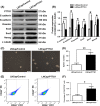Interleukin-6/signal transducer and activator of transcription 3 promotes prostate cancer resistance to androgen deprivation therapy via regulating pituitary tumor transforming gene 1 expression
- PMID: 29288516
- PMCID: PMC5834804
- DOI: 10.1111/cas.13493
Interleukin-6/signal transducer and activator of transcription 3 promotes prostate cancer resistance to androgen deprivation therapy via regulating pituitary tumor transforming gene 1 expression
Abstract
Prostate cancer can progress from androgen dependence to androgen deprivation resistance with some unknown mechanisms. The current study aims to explore the possible role of pituitary tumor transforming gene1 (PTTG1) in castration-resistant prostate cancer (CRPC). Initially, we found that PTTG1 expression was significantly increased in androgen-independent prostate cancer cell lines PC3, DU145 and CRPC specimens compared with that in androgen-dependent prostate cancer cell line LNCaP and initial prostate cancer specimens. PTTG1 overexpression significantly enhanced the cell survival rate, clonality and tumorigenicity in LNCaP cells upon androgen-deprivation therapy (ADT). While knockdown of PTTG1 expression significantly elevated the sensitivity of DU145 cells to ADT. The effects of PTTG1 overexpression on LNCaP cells may be ascribed to the induced EMT and increased CD44+ CD24- cancer stem cell population. Furthermore, we detected that PTTG1 expression was regulated by interleukin-6 via activated signal transducer and activator of transcription 3 (STAT3) directly binding to the region -500 to +1 of PTTG1 promoter in LNCaP cells. In conclusion, our results elucidate that interleukin-6/STAT3 activation can increase PTTG1 expression and, consequently, promote the resistance to ADT in CRPC by inducing EMT and increasing the cancer stem cell population, suggesting that PTTG1 may be a novel therapeutic target for CRPC.
Keywords: cancer stem cell; castration-resistant prostate cancer; epithelial-to-mesenchymal transition; interleukin-6; pituitary tumor transforming gene 1.
© 2017 The Authors. Cancer Science published by John Wiley & Sons Australia, Ltd on behalf of Japanese Cancer Association.
Figures






Similar articles
-
The lncRNA PTTG3P promotes the progression of CRPC via upregulating PTTG1.Bull Cancer. 2021 Apr;108(4):359-368. doi: 10.1016/j.bulcan.2020.11.022. Epub 2021 Mar 18. Bull Cancer. 2021. PMID: 33743960
-
[Downregulation of PTTG1 expression inhibits the proliferation and invasiveness and promotes the apoptosis of human prostate cancer LNCaP-AI cells].Zhonghua Nan Ke Xue. 2017 Jul;23(7):589-597. Zhonghua Nan Ke Xue. 2017. PMID: 29723450 Chinese.
-
Interleukin-6 induced overexpression of valosin-containing protein (VCP)/p97 is associated with androgen-independent prostate cancer (AIPC) progression.J Cell Physiol. 2018 Oct;233(10):7148-7164. doi: 10.1002/jcp.26639. Epub 2018 Apr 25. J Cell Physiol. 2018. PMID: 29693262
-
MicroRNAs and drug resistance in prostate cancers.Mol Pharm. 2014 Aug 4;11(8):2539-52. doi: 10.1021/mp500099g. Epub 2014 Apr 29. Mol Pharm. 2014. PMID: 24742219 Free PMC article. Review.
-
Contributions of epithelial-mesenchymal transition and cancer stem cells to the development of castration resistance of prostate cancer.Mol Cancer. 2014 Mar 12;13:55. doi: 10.1186/1476-4598-13-55. Mol Cancer. 2014. PMID: 24618337 Free PMC article. Review.
Cited by
-
What Do We Have to Know about PD-L1 Expression in Prostate Cancer? A Systematic Literature Review. Part 3: PD-L1, Intracellular Signaling Pathways and Tumor Microenvironment.Int J Mol Sci. 2021 Nov 15;22(22):12330. doi: 10.3390/ijms222212330. Int J Mol Sci. 2021. PMID: 34830209 Free PMC article.
-
Immunosenescence promotes cancer development: from mechanisms to treatment strategies.Cell Commun Signal. 2025 Mar 10;23(1):128. doi: 10.1186/s12964-025-02082-6. Cell Commun Signal. 2025. PMID: 40065335 Free PMC article. Review.
-
STAT3 but Not STAT5 Contributes to the Protective Effect of Electroacupuncture Against Myocardial Ischemia/Reperfusion Injury in Mice.Front Med (Lausanne). 2021 Jul 9;8:649654. doi: 10.3389/fmed.2021.649654. eCollection 2021. Front Med (Lausanne). 2021. PMID: 34307396 Free PMC article.
-
The Kraken Wakes: induced EMT as a driver of tumour aggression and poor outcome.Clin Exp Metastasis. 2018 Apr;35(4):285-308. doi: 10.1007/s10585-018-9906-x. Epub 2018 Jun 8. Clin Exp Metastasis. 2018. PMID: 29948647 Review.
-
Inflammation and NF-κB Signaling in Prostate Cancer: Mechanisms and Clinical Implications.Cells. 2018 Aug 29;7(9):122. doi: 10.3390/cells7090122. Cells. 2018. PMID: 30158439 Free PMC article. Review.
References
-
- Jemal A, Bray F, Center MM, Ferlay J, Ward E, Forman D. Global cancer statistics. CA Cancer J Clin. 2011;61:69‐90. - PubMed
-
- Patel LR, Barton MC. TRIM‐ing ligand dependence in castration‐resistant prostate cancer. Cancer Cell. 2016;29:776‐778. - PubMed
-
- Pei L, Melmed S. Isolation and characterization of a pituitary tumor‐transforming gene (PTTG). Mol Endocrinol. 1997;11:433‐441. - PubMed
MeSH terms
Substances
LinkOut - more resources
Full Text Sources
Other Literature Sources
Molecular Biology Databases
Miscellaneous

